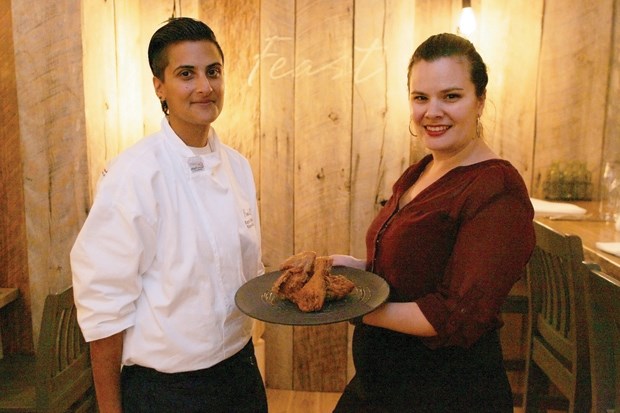The blinking horizontal line of my cursor is imbued with whatever attitude I project on it.
Today, it is an infinitely patient writing companion, encouraging and calm. “Whenever you’re ready, I’m here,” it seems to be saying from the lonely expanse of a largely blank page.
Other days, it is a peevish, unforgiving little troll. “What? Nothing to say? Try harder.”
Meanwhile, my phone purrs and blinks in a bid for my attention, its colourful application tiles begging to be updated.
Remarkable as this technology is, it still feels soul-less. So much of my time is occupied with cold, functional technology.
I think that my relationship with technology, less symbiosis than forced co-habitation, goes a long way in explaining why I am so drawn to elements of the rustic in other arenas of my life. Rustic furniture, design, and cuisine: these things speak to me on a profound level. There is something indescribably comforting about a torn piece of crusty bread, for instance, served with a chunk of artisanal cheese on a rough-hewn board, with a splash of wine in a tumbler.
Accompanied by my friend Gil, I recently paid a visit to Feast, the self-billed “Neighbourhood Table” in the Dundarave Fish Market’s old spot on Marine Drive; the restaurant supplied a healthy dose of rusticity.
As our dinner conversation gravitated, as it often does, towards film, we both instinctively reached for our smart phones to verify some trifling detail about a Peter Greenaway flick.
Pausing to survey the room before we extracted our phones, we actually thought better of it; Feast’s raw charms are pleasingly incongruous with IMDB.
I really like this room. The far back wall is constructed of knotted, non-uniform planks of reclaimed wood reminiscent of a barn on a family farm. Extending from the wall outwards down the middle of the restaurant is a long, high communal table canopied by unpolished, coppery lamp fixtures. These design choices create a warm and relaxing atmosphere that lends itself well to extended visits.
That said, general seating is at a series of very small, narrow tables that strain under the burden of multiple plates and seem inconsistent with the roll-up-your-sleeves and-dig-in vibe that the rest of the room works so hard to achieve.
Gil and I began our meal with a dozen oysters from the evening’s fresh sheet.
The bivalve service was classic: raw oysters on the half shell sat atop a tray of crushed ice, accompanied by lemon, mignonette and gorgeously fresh, piquant grated horseradish. At $42 for the dozen, the oysters (Kusshi and Royal Miyagi) pushed the boundary of accessibility, but were sublimely fresh and delicate, forcing us to concede they were worth every penny. A mineral-rich glass of Fevre Petit Chablis paired exceptionally well.
Our meal proceeded with an order of Saltspring mussels in a wonderfully rich broth of white wine, shallots and tarragon that prompted us to order a side of Parmesan fries (from a list of several à la carte accompaniments on the menu) to mop it all up.
A shared order of marrow toast was, to be honest, a bit disappointing. Two slices of slightly over-grilled bread were topped with a decidedly modest film of bone marrow and a liberal helping of tomato agrodolce, a traditional Italian savoury preserve. The marrow, usually so decadently rich and rustic, simply could not find expression from under the dominant tomato.
Our mains, however, stole the show and revealed the talent that is clearly at work in Feast’s kitchen. Gil had whole roasted branzino, European sea bass from the fresh sheet, prepared with Ikebana–like reserve.
The fish was roasted with a simple bouquet garni of fresh herbs that allowed the fish, moist and delicate, to preserve its subtle character. With no side elements on the plate, Gil added an à la carte order of asparagus and mushrooms.
I opted for sockeye salmon served with coppa (cured pork collar), asparagus, and corn and mushroom succotash.
The salmon retained its vital moisture under a perfectly seared and crispy skin and the al dente vegetables of the succotash provided ideal textural contrast. A glass of Truchard Napa Valley Cabernet Sauvignon supplied a sharp counterpoint to the salmon’s butteriness.
Feast’s desserts are wonderfully approachable and pleasing, and include a bag of warm, PNE-like mini-donuts with caramel and strawberry sauces, and a bowl of thick and decadent chocolate ganache with toasted almonds and cinnamon foam.
Broadly speaking, I feel that Feast is at its best when it supports its name and concept with simply prepared, shareable food and drink. It is less effective when it attempts to introduce unnecessarily finicky dining elements (à la carte sides, for instance) that would be more at home in a less rustic venue.
Our bill for two, including oysters, appetizers, mains (with à la carte side dishes), desserts and three glasses of wine each, was $265 before gratuity. Feast is at 2423 Marine Dr. feastdining.ca
Chris Dagenais served as a manager for several restaurants downtown and on the North Shore. A self-described wine fanatic, he earned his sommelier diploma in 2001. Contact: [email protected].



